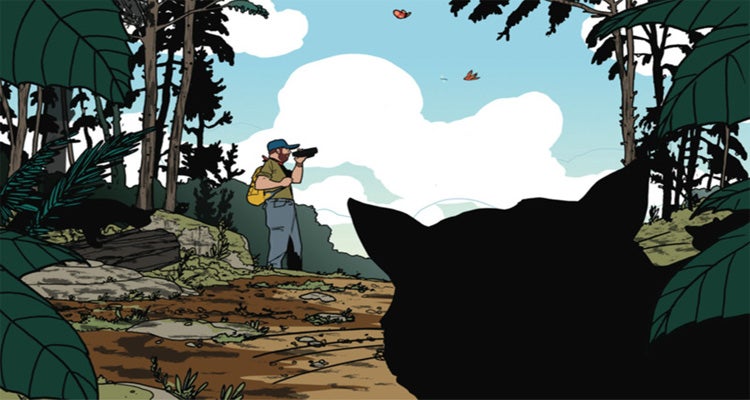Pass/Fail: Spot a Cougar in the Wild

'Illustration by Jason Schneider'
I’ve seen enough charismatic predators in the wild to make a BBC film crew jealous: bears (yes, grizzly and black), wolves, orcas, sea otters, lynx, bobcats, and even wolverines. But there’s always the one that got away, and for me it’s the cougar. I’ve missed out despite spending huge chunks of my entire adult life living and working in the wilderness, which is positively choked with the elusive predators—estimated at 30,000 in North America. The closest I’ve come is a measly paw print.
It’s always burned me up, but maybe it shouldn’t. Mountain lions aren’t so much cats as ninjas: They see at night like we do in the day and can rocket 15 feet into the air, landing 150 pounds of coiled muscle on the ground (or an unsuspecting deer) without so much as crunching a leaf. Their powers of perception are so incredible that even a pro like Utah State University cougar researcher Dr. David C. Stoner gets shut out.
“I’ve been doing this for 20 years, and the number of times I’ve seen them [without radio collars or dogs] is zero,” Stoner says. “Once I was scouting for a female in California. We hiked up on a ridge that was 1.9 miles away from her den and got her in the spotting scope. The whole time she was looking straight at us. I don’t know if she heard us or saw us, but that gives you an idea how far away they can detect movement.”
OK, so my expectations are Mariana Trench low. But spotting one isn’t impossible—every member of my family has seen one the way Stoner says 90 percent of people do: by surprising it in a car on a mountain road, stealing a blink-and-you-miss-it glimpse before the animal vanishes. (That burns me up, too.)
But I’m determined to cross this big cat off my list. Fortunately, I live near Vancouver Island, home to the densest population of cougars in North America. About 900 live on the Island, and YouTube is littered with videos of residents running into big kitties. It’s also home to the most attacks—about one per year over the last decade—though there have been no fatalities.
I target a section of the Juan de Fuca Marine Trail because it’s wild and crowded with deer, cougars’ primary prey. I’m hoping the booming surf nearby can partially obscure my noise. And I’m hiking the remote, 6-mile stretch between Sombrio Beach and Parkinson Creek in early summer, when newly minted adults start looking for fresh home ranges and are most likely to come into contact with humans. To better my chances, I’m doing everything you’re not supposed to do according to the trailhead warning placard: hiking alone, staying quiet, and sneaking around at dawn and dusk, when cougars are most active.
At sunset, I push up from the beach bluff into a wall of salal and stunted pines so tight they tug at my zippers. I’m looking for a meadow with edge habitat—a transition between ecosystems—where deer feed and cougars stalk. At the forest’s edge, I plunk myself down. With light fading, I strain to hear anything interrupt the grave-quiet forest. Nothing—but then again, that’s what a cougar sounds like. I suddenly realize that it’s one thing to know mountain lions are out there, but it’s another to go looking for them at dark on a small island that sees one attack a year. I wonder, has this year’s happened? I listen and squint into the black, wanting and not wanting a lion to appear. I retreat to my tent when it starts pouring—feeling oddly thankful for bad weather.
I rise again the next morning at sunrise and head to a black fringe of forest. There’s a saying about mountain lions, and I feel it acutely: “You don’t see them, but they most definitely have seen you.” I can feel 100 eyes on me. The rainforest is so quiet, every stick-cracking footstep sounds like a gunshot.
Finally, I find ideal edge territory: a pattering stream lined by wide banks of lush, green grass. Fresh deer droppings pile on a rock. If I were a cougar looking for a hot breakfast of deer or dumb person, this would be the place. I tuck myself in a tree hollow, pull my black and camo layers close, and wait. The beach rocks go lavender, the morning clouds peach.
Eventually, shafts of bright sunlight pour through the trees, telling me the game is up. The biggest predator I saw was a salamander. Burned again.
The Verdict: Fail
I didn’t see my cougar. But it wasn’t a total loss. I got better at moving quietly, just stopping to let the rainforest and sunrise grow over me in a particularly promising spot. It’s something I’ll spend time doing and enjoying every time I visit mountain lion habitat, which is almost anywhere wild. The best thing I can do to increase my chances of seeing one is doing more of what I love most—hiking—and slowing down a little when I do it. You know, stop and smell the elk droppings. And maybe one day, if I’m incredibly lucky (or unlucky, depending on how things go), I’ll get my lion.
How to Protect Yourself From a Cougar
Mountain lion attacks are exceedingly rare (there have only been three fatal attacks in North America since 2000), but in the event you’re lucky enough to see one and it acts aggressively, here’s what to do:
- Make yourself look big. Raise your arms or pull your jacket open.
- Shout loudly and make eye contact. You want the lion to think you’re a threat.
- Don’t run or play dead. You don’t want to trigger the lion’s prey instinct.
- If it attacks, fight back. Throw rocks, throw sticks, throw punches, whatever it takes.